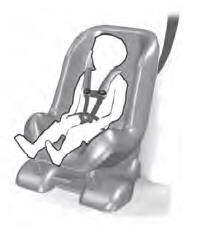Lincoln Aviator 2020-2025 Service Manual / Electrical / Information and Entertainment Systems / Information and Entertainment System - General Information / Removal and Installation - Rear Door Tweeter Speaker
Lincoln Aviator: Information and Entertainment System - General Information / Removal and Installation - Rear Door Tweeter Speaker
Removal
NOTE: Removal steps in this procedure may contain installation details.
-
Remove the rear door trim panel.
Refer to: Rear Door Trim Panel (501-05 Interior Trim and Ornamentation, Removal and Installation).
-
Remove the screws and the front door tweeter speaker.
Torque: 22 lb.in (2.5 Nm)
.jpg) |
Installation
-
To install, reverse the removal procedure.
 Removal and Installation - Rear Door Speaker
Removal and Installation - Rear Door Speaker
Removal
NOTE:
Removal steps in this procedure may contain installation details.
All vehicles
Remove the rear door trim panel.
Refer to: Rear Door Trim Panel (501-05 Interior Trim and Ornamentation, Removal and Installation)...
 Removal and Installation - Roof Mounted Antenna
Removal and Installation - Roof Mounted Antenna
Removal
Lower the headliner.
Refer to: Headliner - Lowering (501-05 Interior Trim and Ornamentation, Removal and Installation).
Disconnect the antenna cable connector(s)...
Other information:
Lincoln Aviator 2020-2025 Service Manual: Removal and Installation - Rear Door Window Glass
Removal NOTE: LH (left-hand) side shown, RH (right-hand) side similar. Remove the rear door window top run. Refer to: Rear Door Glass Top Run (501-11 Glass, Frames and Mechanisms, Removal and Installation). Remove the rear door window glass...
Lincoln Aviator 2020-2025 Service Manual: Diagnosis and Testing - Parameter Identification (PID) Chart
Diagnostic PID Chart PID Acronym PID Name Description APP APP sensor APP APP1 APP sensor 1 APP 1 AST Time Since Start Time (in seconds) since the vehicle was started CLRDIST Distance since DTC cleared Distance driven since PCM DTCs were cleared ECT TCM ECT TCM Engine coolant temperature data provided to the TCM ENGLOAD Engine Load Engine load calculated by PCM ETC_ACT Electronic Throttle Control Actual Electronic Throttle Control Actual calculated by PCM FOOT_BRAKE Foot Brake - Foot brake state used by strategy Foot brake state used by strategy calculated by PCM GEAR_CMD Gear Commanded by Module PCM commanded transmission gear GEAR_ENGAGED Transmission Gear Engaged Transmission Gear Engaged GEAR_OSC# Gear Commanded by Output State Control Output state control commanded gear ISS_A_QF Transmission Input Shaft Speed Sensor -A- Quality Factor Transmission Input Shaft Speed Sensor -A- Quality Factor ISS_A_RAW Intermediate Speed -A- Raw Intermediate Speed -A- Raw ISS_B_RAW Intermediate Shaft Speed -B- Raw Intermediate Shaft Speed -B- Raw ISS_B_QF Transmission Input Shaft Speed Sensor -B- Quality Factor Transmission Input Shaft Speed Sensor -B- Quality Factor LINEDSD# Line Pressure Control Desired Commanded line pressure MIL_DIS The distance travelled since the (MIL) was activated The distance travelled since the MIL was activated OSS_QF Transmission Output Shaft Speed Sensor Quality Factor Fault status for the OSS sensor OSS_RAW Output Shaft Speed - Raw Actual speed of the OSS sensor (rpm) PCA Pressure Control Solenoid A LPC PCA AMP# Pressure Control Solenoid A LPC PCA_F Pressure Control Solenoid A Status LPC PWRT_FUNCMON_A Powertrain Secondary Monitor/Performance Fault A Powertrain Secondary Monitor/Performance Fault A PWRT_FUNCMON_B Powertrain Secondary Monitor/Performance Fault A Powertrain Secondary Monitor/Performance Fault A REALTIME Total time (ECU) has been active ECU Time running RPM_TCM Engine Revolutions Per Minute Engine rpm input to TCM SHFT_DROP Shift RPM Drop in Input Shaft Speed Below Expected Shift rpm drop in input shaft speed below expected SHFT_FLRE Shift RPM Rise in Input Shaft Speed Above Expected Shift rpm rise in input shaft speed above expected SHFT_ID Shift Identification of Shift (PID)s Lag, Time, Flare and Drop Shift identification of shift PIDs lag, time, flare and drop SHFT_LAG Shift Time Elapsed From 10% to 90% of Complete Actual time during shift between 10% and 90% complete SHFT_TIME Shift Time Elapsed From Commanded to 10% Complete Shift time 0% to 10% complete SNOWPLW_CFG Snowplow as configured in the (PCM)...
Categories
- Manuals Home
- Lincoln Aviator Owners Manual
- Lincoln Aviator Service Manual
- Locking and Unlocking
- Drive Modes
- Refueling
- New on site
- Most important about car
Child Seats

Use a child restraint (sometimes called an infant carrier, convertible seat, or toddler seat) for infants, toddlers and children weighing 40 lb (18 kg) or less (generally four-years-old or younger).
Using Lap and Shoulder Belts
WARNING: Do not place a rearward facing child restraint in front of an active airbag. Failure to follow this instruction could result in personal injury or death.
Copyright © 2025 www.liaviator2.com
